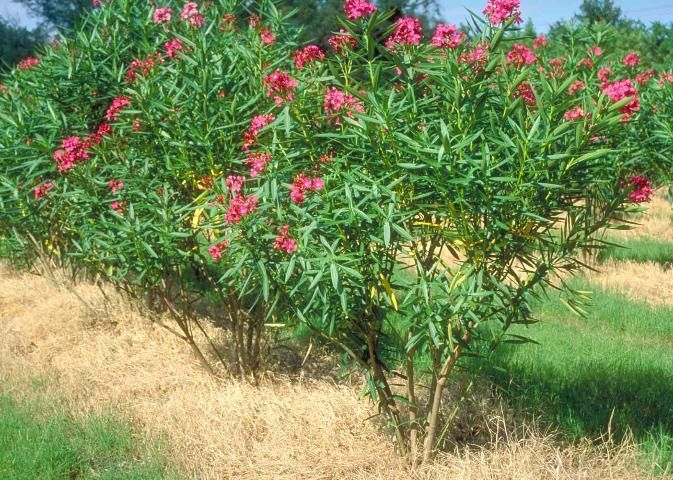Introduction
Oleander is a wonderful easy-care, rounded shrub or small tree, with long, dark green leaves and an abundance of single or double, sometimes fragrant flowers. 'Calypso' has single, cherry red flowers and is very hardy. Often trained into an attractive small tree, multi-branched oleander also does well as a quick-growing screen or large specimen planting. Planted on five to seven foot centers, a row of oleander makes a nice screen for a large residence or other large-scale landscape.

Credit: UF/IFAS Extension
General Information
Scientific name: Nerium oleander
Pronunciation: NEER-ee-um oh-lee-AN-der
Common name(s): 'Calypso' oleander
Family: Apocynaceae
USDA hardiness zones: 8B through 11 (Fig. 2)
Origin: not native to North America
Invasive potential:has been evaluated using the UF/IFAS Assessment of the Status of Non-Native Plants in Florida's Natural Areas (Fox et al. 2005). This species is not documented in any undisturbed natural areas in Florida. Thus, it is not considered a problem species and may be used in Florida.
Uses: reclamation; urban tolerant; screen; specimen; trained as a standard; container or planter; hedge; deck or patio; parking lot island < 100 sq ft; parking lot island 100-200 sq ft; parking lot island > 200 sq ft; tree lawn 3-4 feet wide; tree lawn 4-6 feet wide; tree lawn > 6 ft wide; sidewalk cutout (tree pit); highway median
Availability: not native to North America

Description
Height: 10 to 18 feet
Spread: 10 to 15 feet
Crown uniformity: symmetrical
Crown shape: round, vase
Crown density: moderate
Growth rate: fast
Texture: medium
Foliage
Leaf arrangement: opposite/subopposite (Fig. 3)
Leaf type: simple
Leaf margin: entire
Leaf shape: linear, lanceolate
Leaf venation: pinnate
Leaf type and persistence: evergreen
Leaf blade length: 2 to 4 inches, 4 to 8 inches
Leaf color: green
Fall color: no color change
Fall characteristic: not showy

Flower
Flower color: red
Flower characteristics: very showy
Fruit
Fruit shape: elongated
Fruit length: 3 to 6 inches
Fruit covering: dry or hard
Fruit color: unknown
Fruit characteristics: does not attract wildlife; not showy; fruit/leaves not a litter problem
Trunk and Branches
Trunk/bark/branches: branches don't droop; not showy; typically multi-trunked; thorns
Pruning requirement: needed for strong structure
Breakage: susceptible to breakage
Current year twig color: green
Current year twig thickness: thick
Wood specific gravity: unknown
Culture
Light requirement: full sun, partial sun, or partial shade
Soil tolerances: sand; loam; clay; acidic; alkaline; well-drained
Drought tolerance: high
Aerosol salt tolerance: moderate
Other
Roots: not a problem
Winter interest: no
Outstanding tree: no
Ozone sensitivity: unknown
Verticillium wilt susceptibility: resistant
Pest resistance: sensitive to pests/diseases
Use and Management
Growing well with only one yearly fertilization and springtime pruning, oleander is one of the easiest shrubs to care for. Sometimes suckers produced at the base of the plant will siphon off too much energy and flowering will be inhibited. These suckers should be pulled to remove them when they are young and succulent. The plant can be trained into a short central leader in the nursery and is often sold as a "standard" oleander. It grows into a round-headed ball, flowering year-round in USDA hardiness zones 9b through 11. Flowering is reduced in winter in USDA hardiness zone 9a.
All parts of the plant are poisonous so care must be taken when locating oleander near areas frequented by small children; burning of the trimmings will produce toxic fumes. Even chewing once or twice on a leaf or twig can send a person to the hospital.
Oleander survives drought extremely well and is well-suited to growing on soil too poor for most other plants, even tolerating salt spray, brackish water, and alkaline soil. Oleander needs full sun to perform its best, appearing too lanky and flowering little if planted in partial shade. The oleander caterpillar can defoliate a plant within a week or two, and it is common in south and central Florida. It is commonly planted in highway medians as a no-maintenance plant. It grows in wet weather, slowing down in drought but never appears damaged by even severe drought.
Many Oleander cultivars are available: 'Compte Barthelemy' has double red flowers; 'Mrs. Roeding', double pink flowers; 'Sister Agnes', single pure white flowers; 'Isle of Capri', single, light yellow flowers; 'Hawaii', single salmon-pink flowers with yellow throats; and dwarf cultivars 'Petite Pink' and 'Petite Salmon'. 'Variegata' and 'Variegatum Plenum' have variegated leaves.
Propagation is by cuttings.
Pests
Pest problems are scale and oleander caterpillar which can do quite a bit of damage to the foliage if left unchecked. Oleander caterpillar can defoliate a plant in a week or two.
Diseases
No diseases are of major concern.
Literature Cited
University of Florida, Institute of Food and Agricultural Sciences. 2018. "Assessment of Non-native Plants in Florida's Natural Areas" (https://assessment.ifas.ufl.edu, 4/29/2019) Gainesville, FL, 32611-4000, USA.